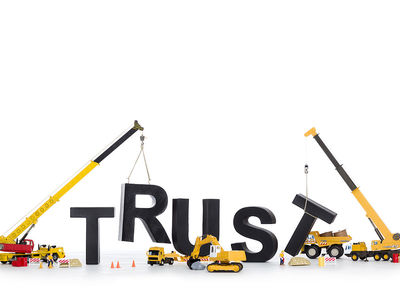
As Stephen M.R. Covey notes in his book The Speed of Trust, trust is an incredibly effective lubricant on the wheels of any organization’s operation. Put simply, a lack of trust is a time and resource tax on your organization, while trust facilitates speed and operational efficiency. So how can an organization foster trust?
Most of the answers I have found to this question are either complicated to understand and difficult to implement or woefully incomplete. Comprehensive sources, like “Speed of Trust,” can be overwhelming because of all of the moving parts. On the other hand, trite advice like I recently read in the Wall Street Journal to simply give candid critiques don’t go far enough. Is there a useful middle ground?
In my experience, there are four possible ways to communicate to solve problems. They are direct without empathy, direct with empathy, indirect with empathy, and indirect without empathy. Let’s evaluate all four starting with the least effective. Communication that is indirect and lacks empathy is simply gossip and will not only never solve a problem, but will always lead to a reduction in trust. I believe leaders should never tolerate this form of communication. Next, direct communication without empathy, or what I call “in your face” communication, effectively delivers the message of critique to the person who can effect change, but does so in a way that builds animosity and enmity over time and destroys trust. Over time, the person receiving the communication becomes less and less open to hearing it or acting on it. The third type of communication, indirect with empathy, or what can be called “strategizing communication,” is when people talk together with the express purpose of figuring out how best to deliver a message to a third party about how to improve. While this approach may be useful to identify an effective path forward, it does not by itself solve any problems or build any trust. The only option that both solves problems and builds trust is direct communication with empathy, or “participative candor.” This approach is honest, often brutally so. But it is ALWAYS coupled with supporting elements that outline the way the deliverer of the information will be involved in helping the hearer of the information make the changes needed to address the problem. Put simply, the deliverer of the information cannot be divorced from the solution. No one can simply “drop” off a problem, but must also be an active participant in the solution.
| With Empathy | Without Empathy | |
|---|---|---|
| Direct | Participative Candor—Here’s what’s wrong that we should fix together | In Your Face—Here’s what’s wrong that you should fix |
| Indirect | Strategizing—how can we help this person? And/or how should I best talk to this person | Gossip—I don’t like this about the person |
So how do you get participative candor? I think you can do this in four fairly easy steps:
- Seek critique
- Engage in direct channel communication
- Commit to finding shared improved outcomes
- Eliminate ALL back-channel gossip
First, ensure that everyone in the team understands that your organization values continuous improvement and that continuous critique is not only welcomed but invited. This is a “seek for critique” culture. For this to work, continuous critique has to be equally applied to all levels of the organization, from the front line to the CEO. No one can be immune from critical feedback.
Second, all critical feedback must be communicated directly between the person or group with the problem and the person or group with the solution. I call this “direct channel” communication. Back-channel communications are NOT effective at solving problems. The double whammy is that they also erode trust while not accomplishing anything.
Third, once delivered, all critical feedback MUST come with a commitment to help the individual or team improve their outcomes. I like to call this empathy “the love factor.” I once worked for an organization that was incredibly good at points one and two. People were open to critique, at least early in my experience there, and they communicated directly and avoided back-channel conversations. But there was no love in the communication. Eventually everyone began to think of her coworker as an enemy, not a friend; someone willing to point out the flaws, but not someone who had their back and was willing to help find solutions. Love, or empathy, is shown most clearly through efforts to help the individual or team with the problem improve their performance. Whenever a critical evaluation is levied against another team or individual, it should always be accompanied with possible solutions THAT INCLUDE the participation of the critiquing team or individual.
Finally, there is NO place for back channel communication. Ever. Conversations between those with the problem and those that cannot solve it serve no purpose but to undermine trust. Organizations that want to work at “the speed of trust” cannot permit these kinds of conversations. Don’t misunderstand, strategizing conversations on how to help individuals or teams prepare to directly communicate with the problem team or individual are helpful. Beyond this, however, little if anything positive comes from the back channel.
To summarize, building a trust-based performance model for your organization comes from the following: seek for critique, have direct discussions; Apply the love factor and commit to improving individual and shared outcomes; and never allow back channel communications. These steps won’t work overnight, but consistently applied they work over time, every time.